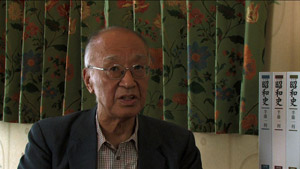Click here for a full list of the Art and Artists in the film

Hamaya Hiroshi
Magnum photographer who photographed the ANPO demonstrations throughout May and June, 1960.

Nakamura Hiroshi
Painter who painted Japanese reactions to U.S. military presence throughout the 1950s, the ANPO struggle of 1960 and more. Full access to work.

Aida Makoto
Prolific and political artist working in a wide range of mediums from oil painting, manga, sculpture and photography. His work reflects the contradictions of the legacy of WWII and of 21st century life.

Ishiuchi Miyako
Photographer raised near the Yokosuka U.S. Navy base. Her first photo book, Yokosuka Story, won the top Kimura Ihei Prize. Her photo series, Hiroshima was awarded the Mainichi Culture Award. In 2014, she was awarded the Hasselblad Award.

Kazama Sachiko
Encouraged to question authority by her father, a leader in the 1960 ANPO demonstrations, Kazama makes large-scale black and white manga-style woodblock prints which excavate controversial events from Japan’s recent past.

Yamashita Kikuji
Defining postwar surrealist, reportage painter and artist politically active throughout the postwar. His experience as an Imperial soldier in China during the war resulted in paintings reflecting the profound contradictions of postwar Japan.

Ikeda Tatsuo
Painter active from the 1950s who embraced the Reportage painting movement. Assigned to the Kamikaze squads as a teenager during WWII, Ikeda considered himself to have been reborn in the postwar era.

Kato Tokiko
Legendary singer/songwriter who demonstrated in 1960 ANPO and wrote the anthem, “Lullabye for Sleeping Alone” to her husband who was jailed for demonstrating against the Vietnam War.

Inoue Chozaburo
A prolific painter who painted anti-war paintings during the war. He continued to paint, including a series of satirical paintings of corrupt politicians.

Ishikawa Mao
An Okinawan photographer, Ishikawa began photographing when the 1970 demonstrations against the U.S. bases turned violent. For her series, Fences, Okinawa, she walked around and photographed all the base fences in Okinawa.

Ishii Shigeo
Postwar painter who expressed the acute contradictions of postwar Japan in his extended series “Violence” and “Under Martial Law.” Died at 32 in 1961.

Hosoe Eikoh
Photographer renowned for dramatic photos of Mishima Yukio, he made high-contrast controversial nude photos of Butoh dancer, Hijikata Tatsumi to express his outrage during the 1960 ANPO struggle.

Tomatsu Shomei
Leading postwar Japanese photographer. Hired by anti-nuclear group to photograph Nagasaki survivors immediately after ANPO extension passed in 1960. Extensively photographed around U.S. bases in Japan.

Yokoo Tadanori
Megastar pop artist of 1960s and 70s. Famous for poster art of avant garde theater in late 1960s. Participated in 1960 ANPO demonstrations and drew satirical illustrations of Prime Minister Eisaku Sato in 1970, rejected by Time magazine as too political.

Kushida Kazuyoshi
Renowned for staging Brechtian interpretations of Kabuki, Kushida urged his classmates as a 17 year-old to join the 1960 ANPO demonstrations, and wrote an essay about his political analysis of the political situation.
Nagano Shigeichi
A renowned photojournalist who extensively photographed 1960 ANPO and Japan’s hyper-growth and industrialization.
Nagahama Osamu
A celebrated commercial and portrait photographer, Osamu traveled to Okinawa at the height of the Vietnam War, documenting how the U.S. used its bases there as the staging grounds for that war.
Filmmakers

Fukasaku Kinji
Director, Under the Flag of the Rising Sun (1972), a film about a WWII widow trying to come to terms with the reality of what really happened to her husband during the war and how the war is remembered in the postwar.
Imamura Shohei
Director, Pigs and Battleships (1961), the first film to explicitly portray the prostitution and crime that flourished around U.S. military bases in Japan.

Tomizawa Yukio
Director, Rage at ANPO (1960), the only documentary film made about the 1960 ANPO protests. Tomizawa directed some 20 film crews who all volunteered their equipment and time to film the most riveting moment of postwar history.
Historians

Hosaka Masayasu
Author, The Truth about the 1960 ANPO Struggle. A respected historian, Hosaka has written extensively about the history of WWII and the postwar.

Tim Weiner
Author, Legacy of Ashes, a comprehensive history of C.I.A. covert activities. As the New York Times C.I.A. reporter, he interviewed many former C.I.A. personnel who supported Kishi and Japan’s Liberal Democratic Party.

Hando Kazutoshi
Author, The History of Showa, the definitive chronicle of the Showa Era. A renowned journalist, he is the former editor of Bungei Shunju.
